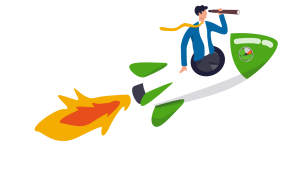How to use single-tasking to get more done

Right now, single-tasking is all the rage, and here’s why.
The modern workplace pulls our attention in all directions. Juggling communication, meetings, and colleagues’ needs takes a big chunk out of your workday, leaving less room to focus on your direct responsibilities.
Even when you finally get to your work, shifting demands and priorities have you hopping task-to-task to put out fires, appease managers, and meet deadlines.
Want to get the most out of your time?
Try DeskTime for free!
Try free for 14 days · No credit card required.
By signing up, you agree to our terms and privacy policy.

While multitasking certainly may feel productive as you’re constantly engaged in work-related matters, at the end of the day, the results often paint a different picture – half-finished tasks and sluggish progress on value-added activities, coupled with considerable mental exhaustion.
If that sounds like you, single-tasking may be the antidote you’ve been looking for.
In this article, we’ll delve into what is single-tasking, the science behind it, and share some useful tips and techniques on how to integrate single-tasking into your workday to boost your productivity.
What is single-tasking and the science behind it
As the name suggests, single-tasking is the practice of focusing on one task at a time, giving it your undivided attention for a certain period of time or until it’s completed. It’s the opposite of multitasking, where you try to juggle multiple tasks simultaneously.
The theory is that by engaging in deep, focused work for a prolonged period of time you’ll be overall more effective at completing a task, than if you were to chip away at it incrementally in-between other work, ultimately boosting your productivity and well-being at work.
Is there any evidence that supports this theory?
Yes, we’re at our best focusing on one thing at a time
Humans are demonstrably bad at multitasking to the point where it can have a bigger negative impact on your productivity than smoking marijuana. Our brains simply aren’t wired to give proper attention to multiple tasks simultaneously. Much like a computer, we have a limited working memory that gets quickly overwhelmed when strained too much, leading to a drop in productivity, increasing the likelihood of mistakes, and contributing to burnout.

The issue at the core of multitasking is context switching, namely, shifting between tasks and tools before finishing the thing you’re currently working on. According to studies, it takes anywhere from nine and a half minutes to 23 minutes to get back into the flow of things after switching tasks. Pair this with the insight that people in knowledge-intensive professions are interrupted at work every four minutes, and it really makes you wonder how anything gets done.
It’s not just about productivity, but well-being, too – task switching is extremely demanding on our energy reserves and sustained multitasking quickly drains them, while leading to a build-up of stress.
“But, hey, I’m not like the others! I’m great at multitasking” – are you really, or do you only think you are? This study suggests that it’s the latter, highlighting that some of the worst multitaskers are those who think they’re great at it.
Single-tasking is an answer to these issues and presents such benefits as higher productivity, better quality of work, and reduced stress and risk of burnout.
Single-tasking seems like a no-brainer, doesn’t it?

Want your productivity to skyrocket?
Get the most out of DeskTime’s power features for time management.
9 tips and tricks for getting started with single-tasking
While the benefits of single-tasking are certainly alluring, the reality of the modern workplace makes it virtually impossible to take absolute control of your time. Urgent tasks will pop up, you will inevitably be interrupted, and, when the CEO writes you, you better answer.
That said, it should still be possible to carve out windows in your day for deep work. There are various dedicated productivity methods designed to help with single-tasking, as well as several smaller steps one can take to find their focus.
1. 52/17 rule
You’ve probably heard of the Pomodoro technique, which involves working in focused 25-minute intervals, followed by a 5-minute break. Well, this 25/5 ratio is outdated and a DeskTime study discovered that the most productive work is in sprints of 52 minutes, followed by 17-minute breaks.

Either ratio works and you may use whichever is more convenient – what really matters is that you spend those minutes on a single task. Set a timer, shut off the outside world, and get to work focusing on one thing at a time.
2. Time blocking
Time blocking means allocating certain parts of your day for specific work and ignoring any distractions that may come your way during that time. This allows you to maintain your focus on the task at hand.
Unlike the 52/17 rule, time blocking typically requires pre-planning and it’s most effective when you can integrate it into your daily schedule across the entire week, i.e. working on your primary responsibility every day from 10:00–13:00.
3. The one-tab rule
Limiting your web browser to a single open tab at a time helps eliminate distractions. The rule is that, within reason, you must finish what you’re doing on that tab before opening another, promoting concentrated work and doing one thing at a time.

4. No-meeting days
An increasingly popular initiative among companies is no-meeting days, where at least one working day is fully meeting-free. Designating specific days or time slots as “no-meeting” periods safeguards uninterrupted time for deep work, and enables the use of other single-tasking practices.
5. Turn off distracting apps
It takes a single message from a colleague or friend to snap you out of a state of flow. So, when engaging in single-tasking, disabling notifications from distracting apps or enabling “Do Not Disturb” mode is key to minimizing interruptions. Silence your phone, close your email, and turn off Slack – else you risk undermining your single-tasking efforts.
6. Put your phone away
If completely silencing your phone doesn’t work, then consider physically distancing yourself from your phone by keeping it out of sight and reach. This can prevent the temptation of checking messages and social media, allowing you to concentrate on your tasks.
7. Take care of smaller tasks in one batch
Single-tasking doesn’t have to take you completely off the grid. Emails and communication are key for any modern company, but to avoid them impacting your work, consider taking care of them at specific times throughout the day, e.g. spending an hour every morning to stay on top of your messages. After all, it’s single-tasking vs multitasking, not single-tasking vs work.
8. Give yourself short deadlines
Also known as time boxing, limiting the time you spend on certain tasks can help you make better use of it. In other words, it’s a way to force yourself to single-task simply by virtue of not having enough time to spend elsewhere.
9. Use DeskTime to track your productivity and availability
Time-tracking apps such as DeskTime can help workers stay on top of their productivity levels, as well as identify productivity windows to dedicate to single-tasking. The latter is particularly challenging when starting out, as your best intentions can be undermined by a hectic schedule or colleagues ignoring that you’re in deep work. Plus, DeskTime’s inbuilt productivity features such as its Pomodoro timer can help you with your single-tasking efforts.

Reclaim your focus
Single-tasking isn’t all or nothing. You don’t have to completely change your ways of working and start ignoring your colleagues. Single-tasking starts with small incremental steps and eventually crafting a working schedule that works for you, within the context of your particular company, team, and availability.
The simple truth of the matter is that multitasking is generally counter-productive and exhausting. By following the tips in this article, you can slowly but surely reclaim some of your focus and become a more productive and happier person doing it.
Did you find this article useful? Give it a clap!
Psst! You can clap more than once if you really loved it 🙂